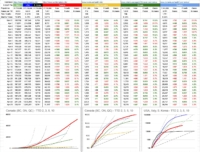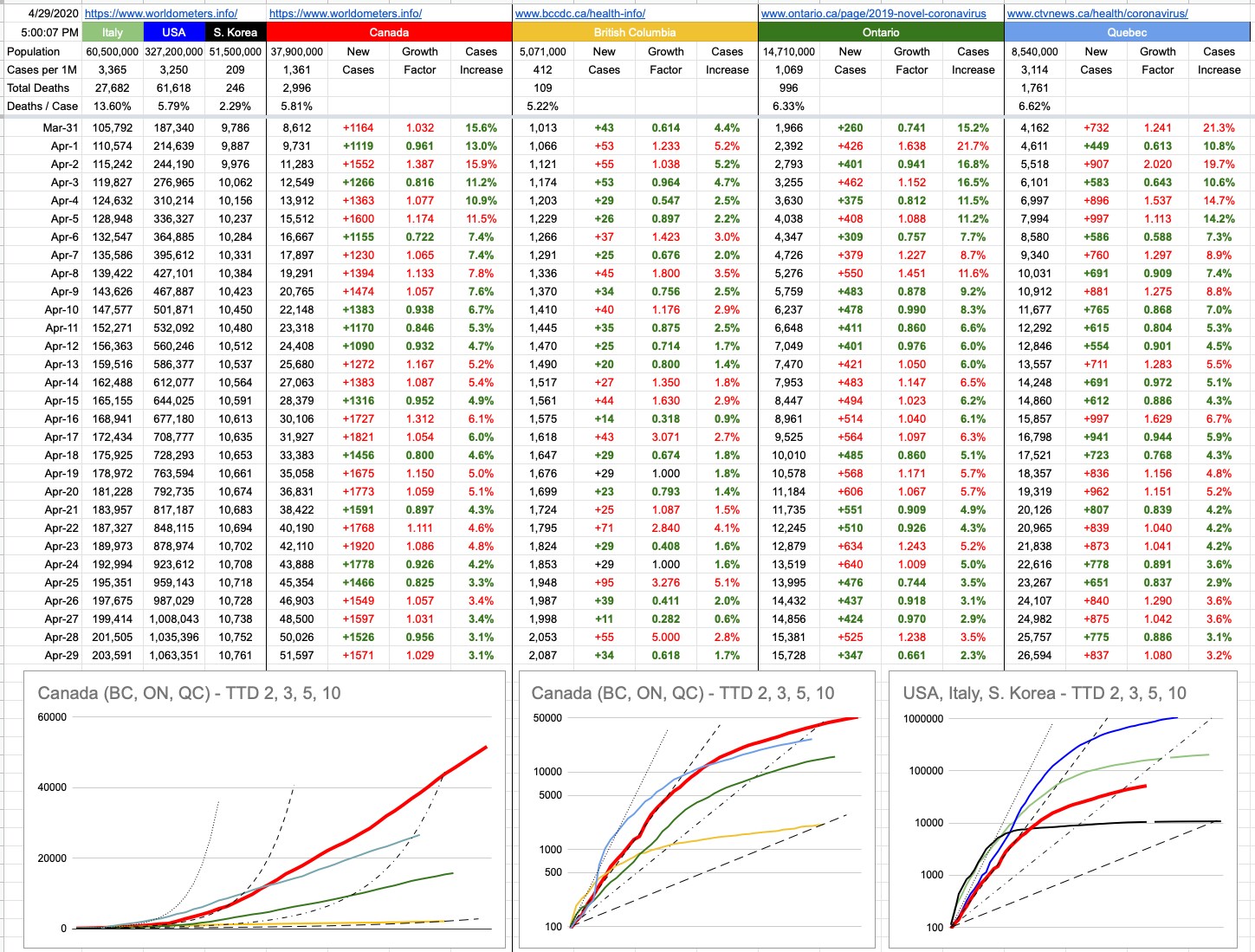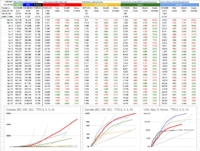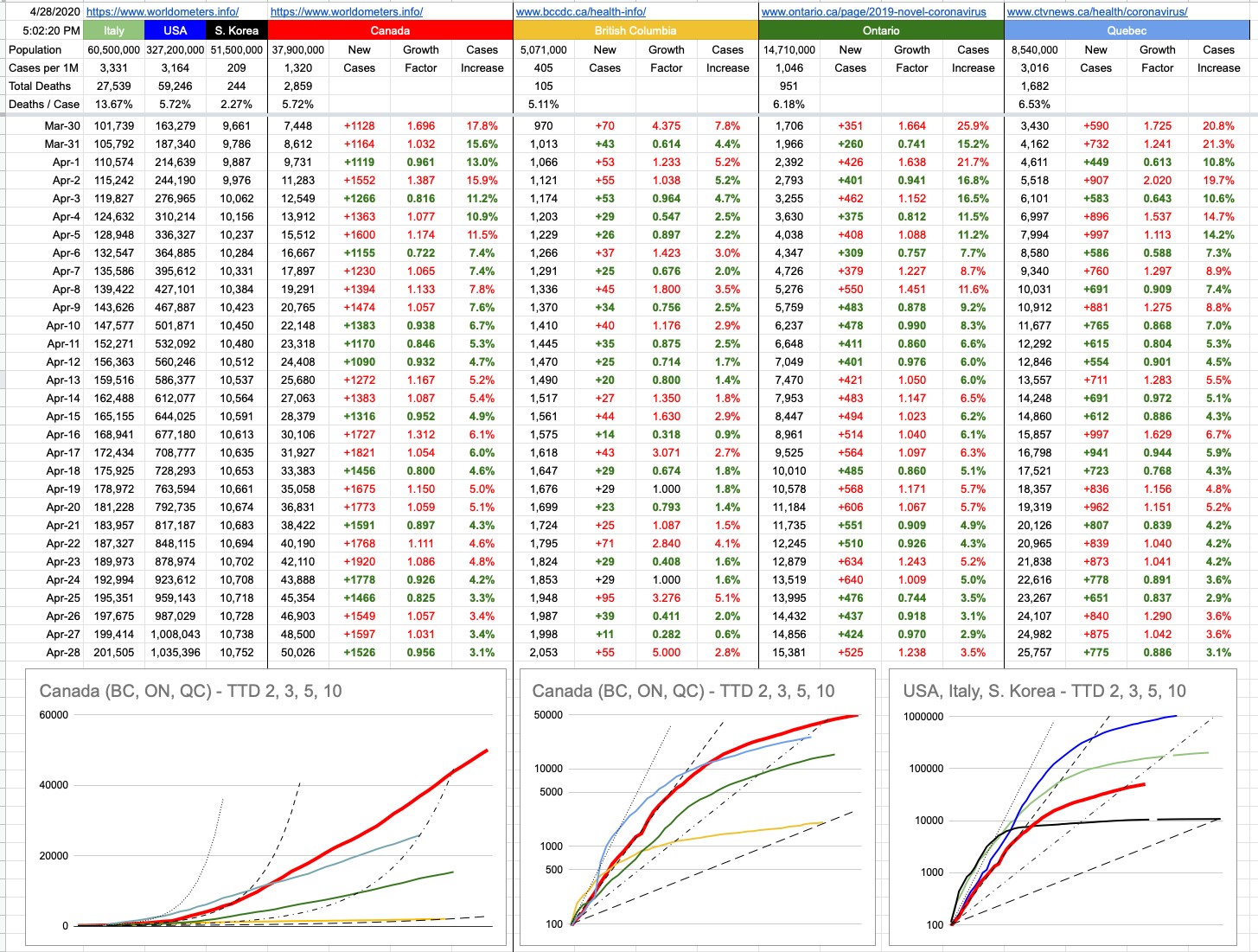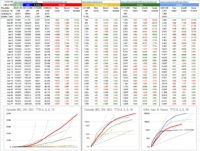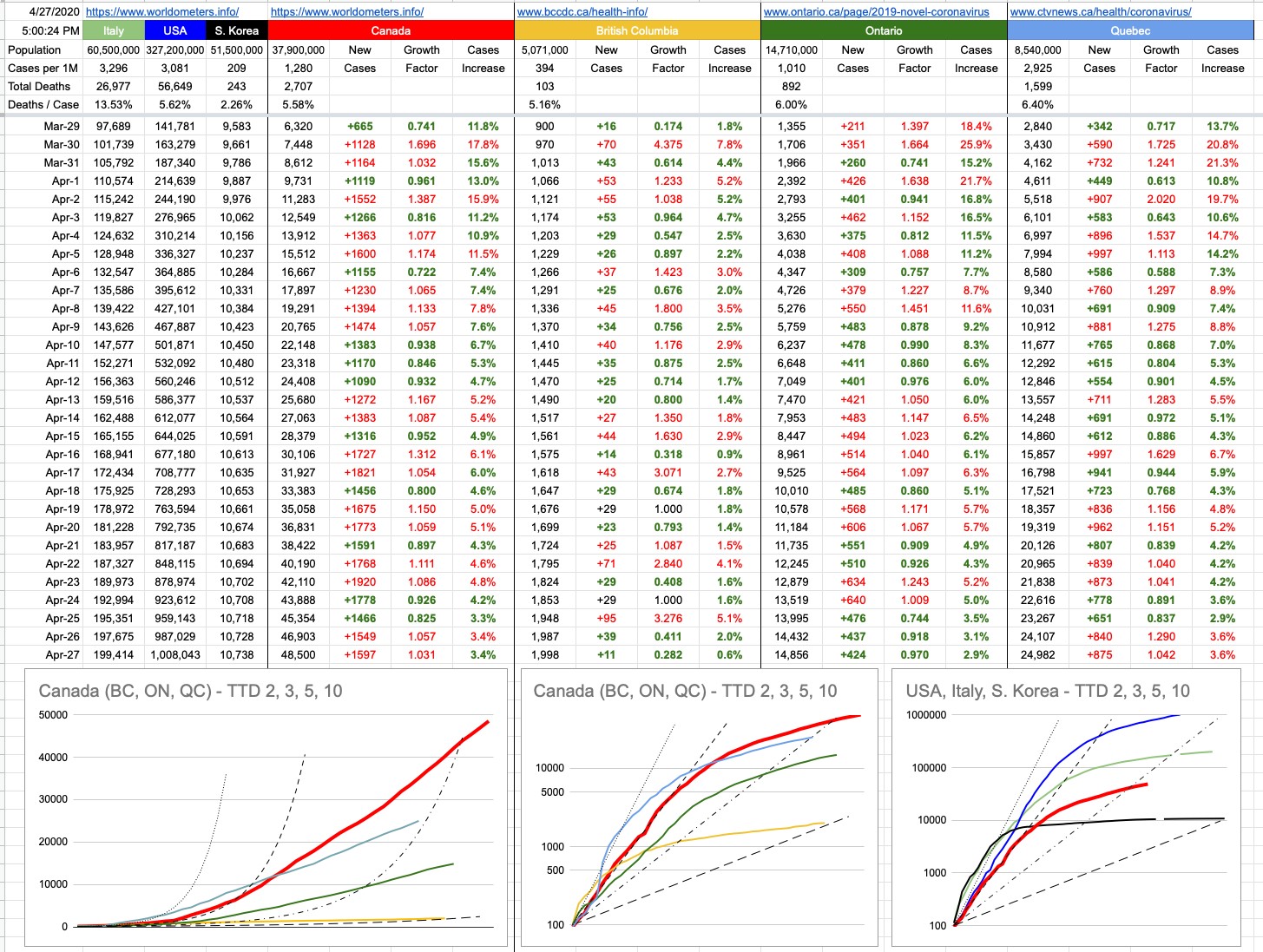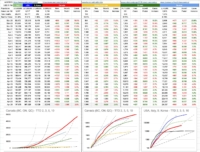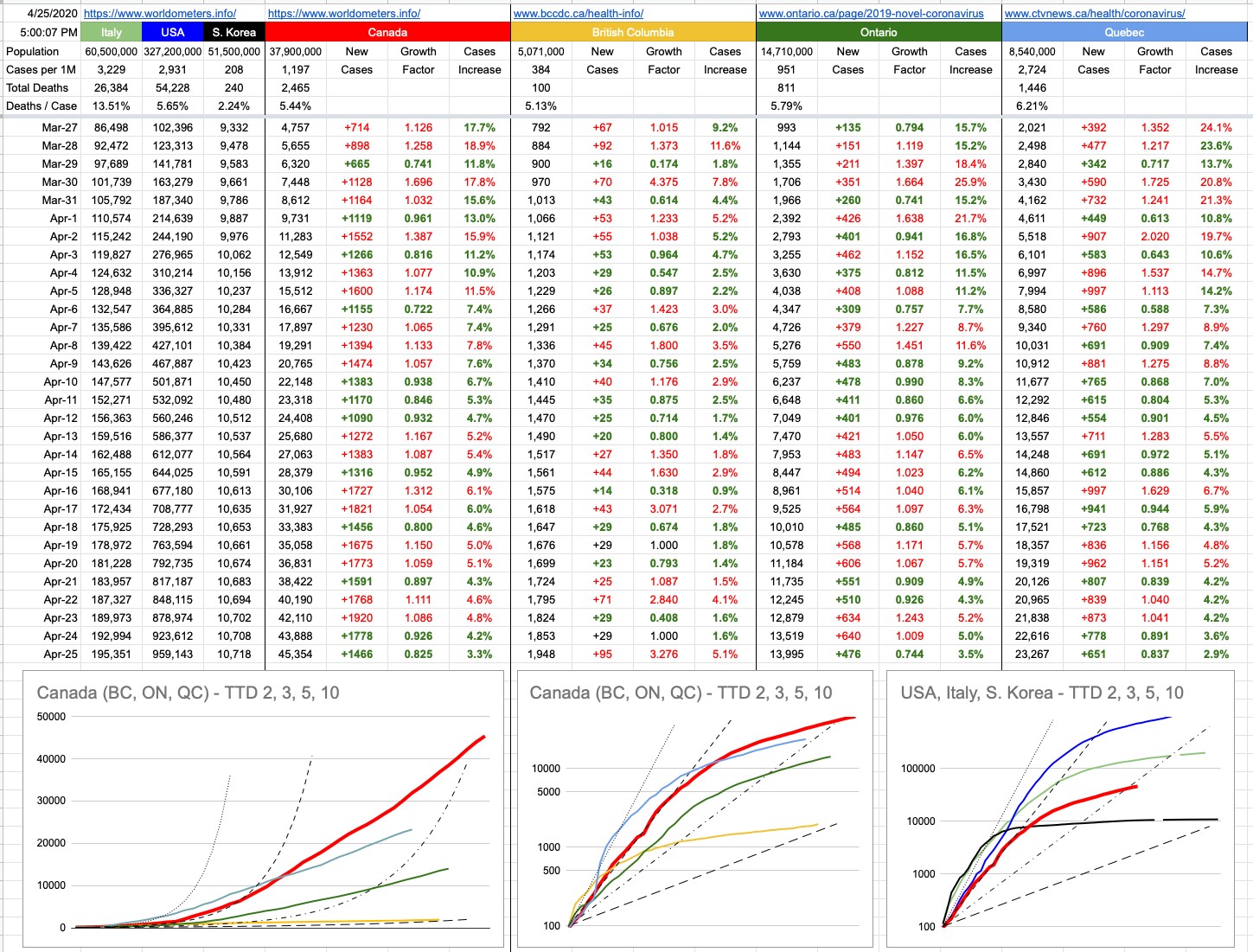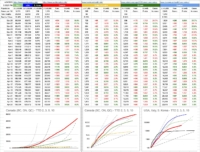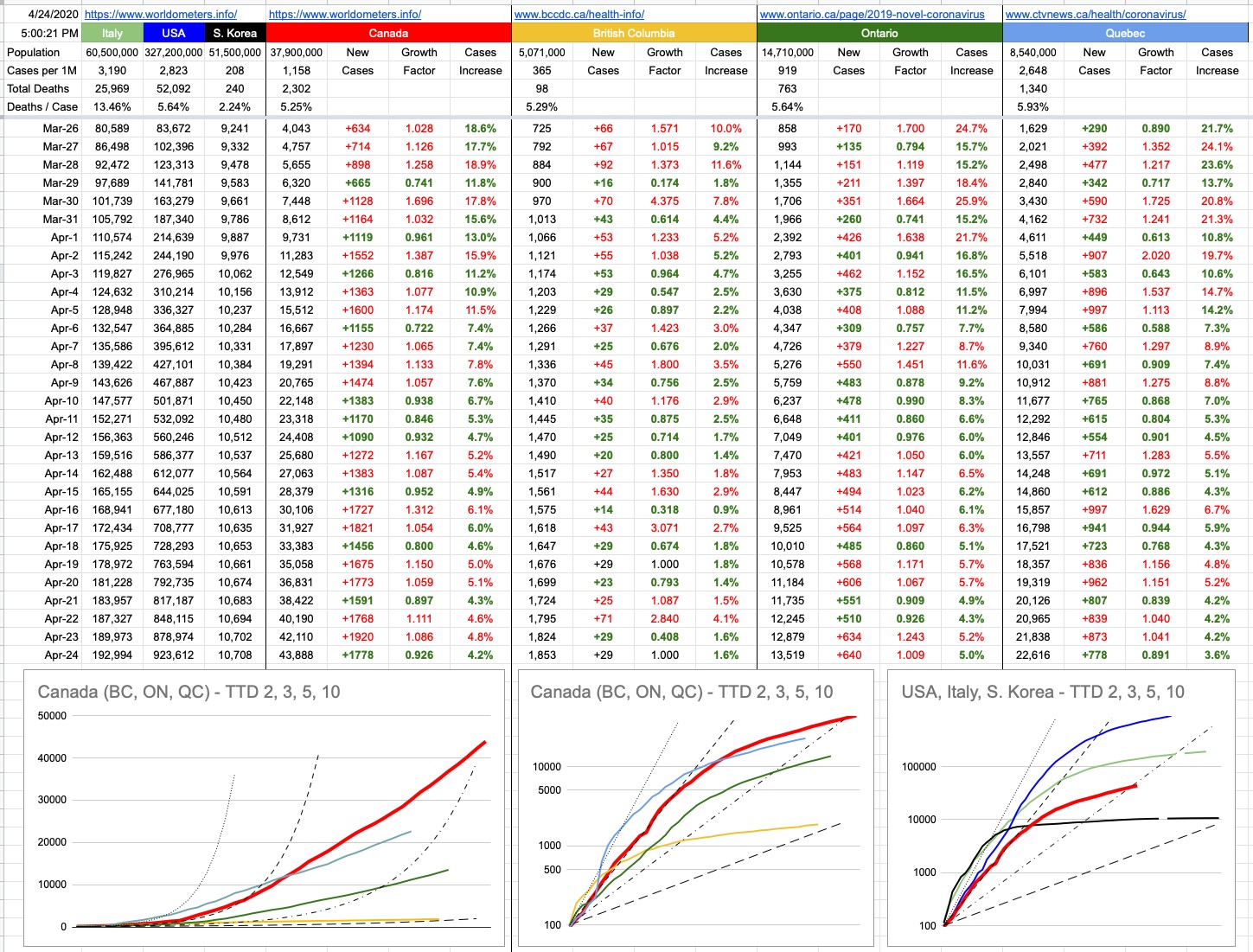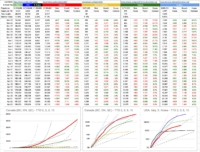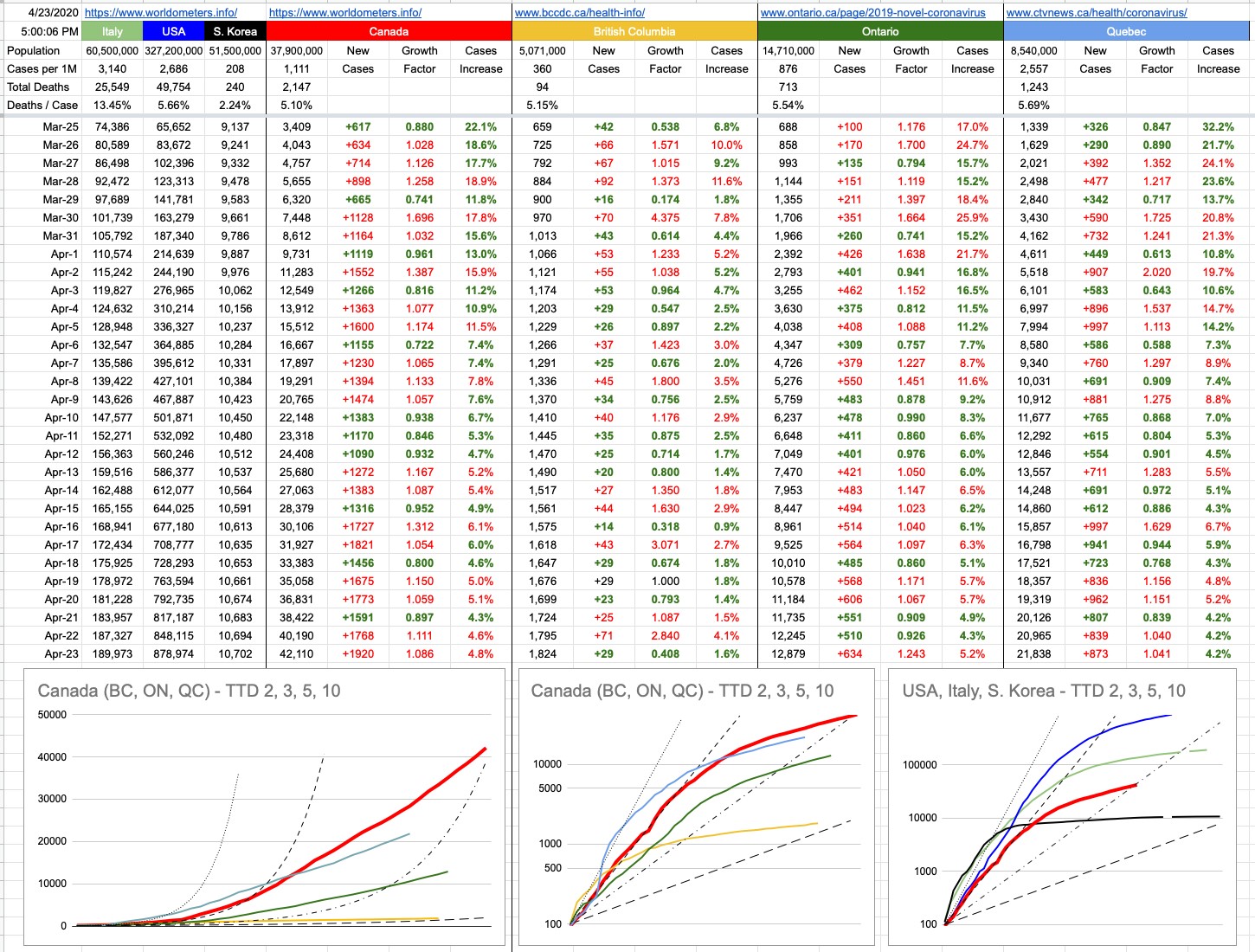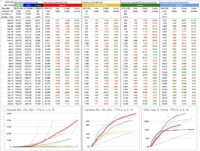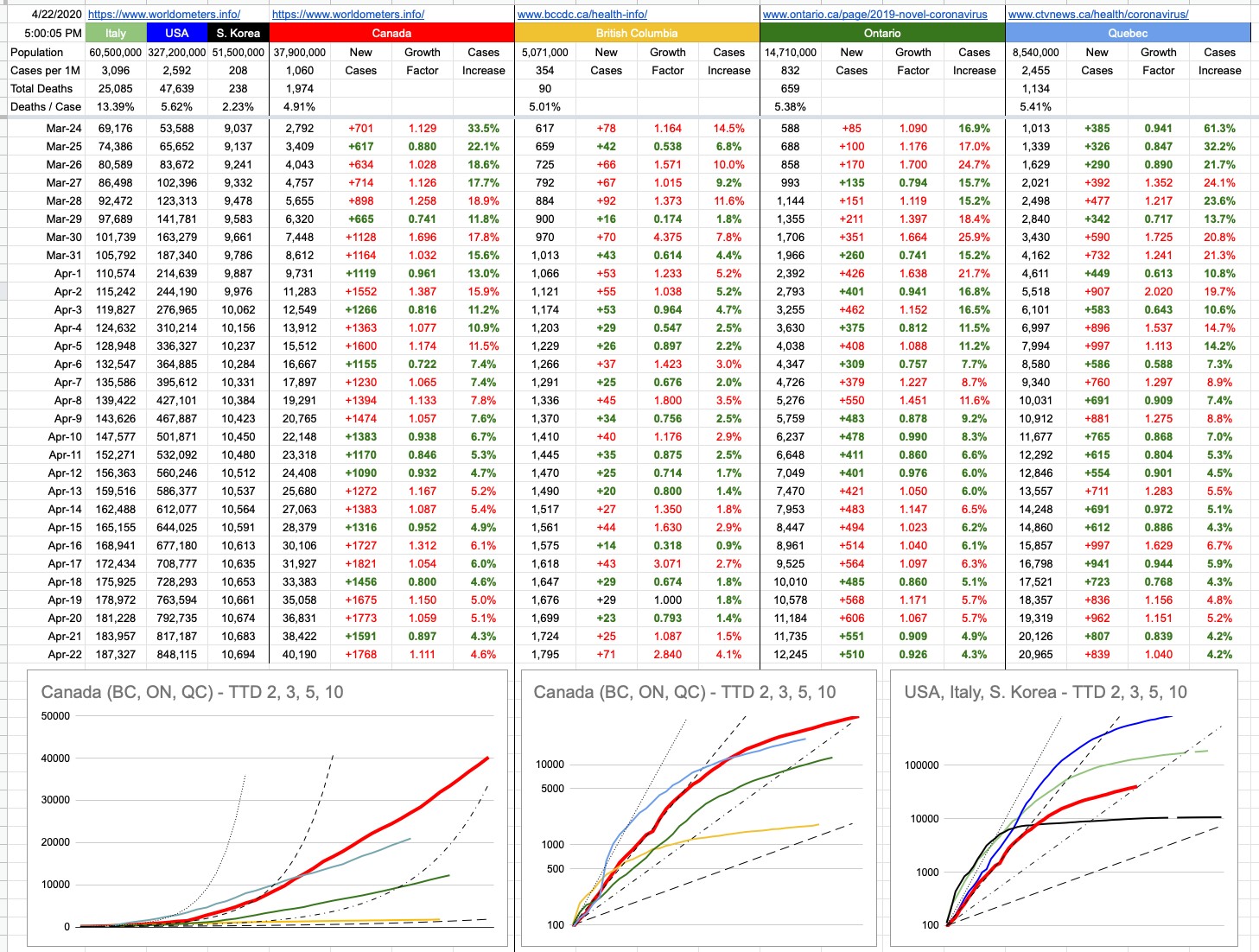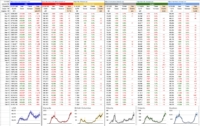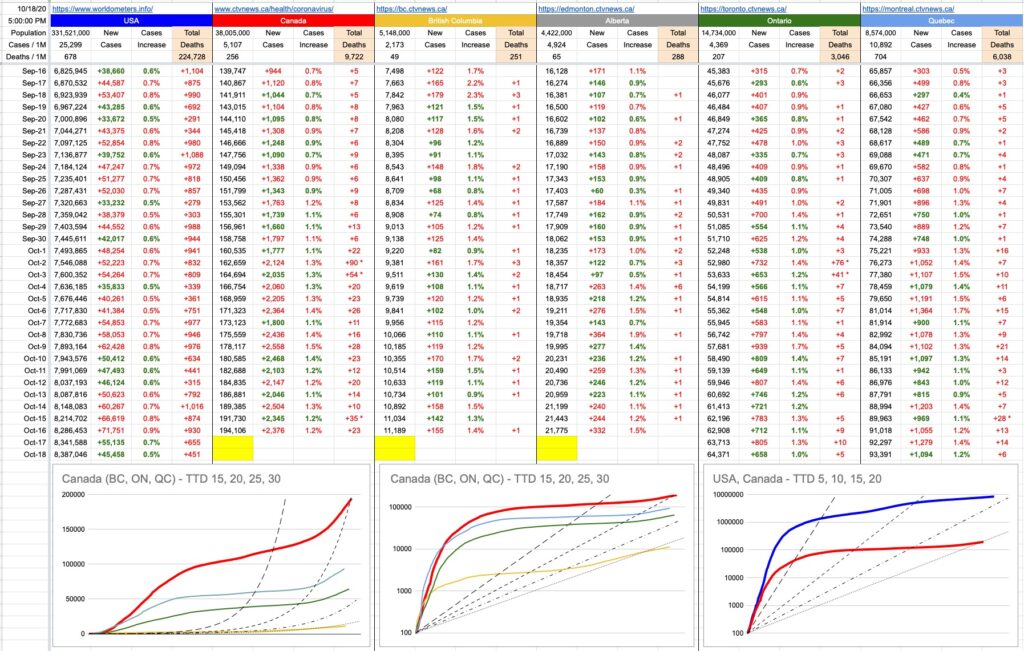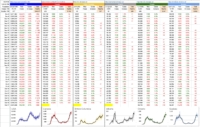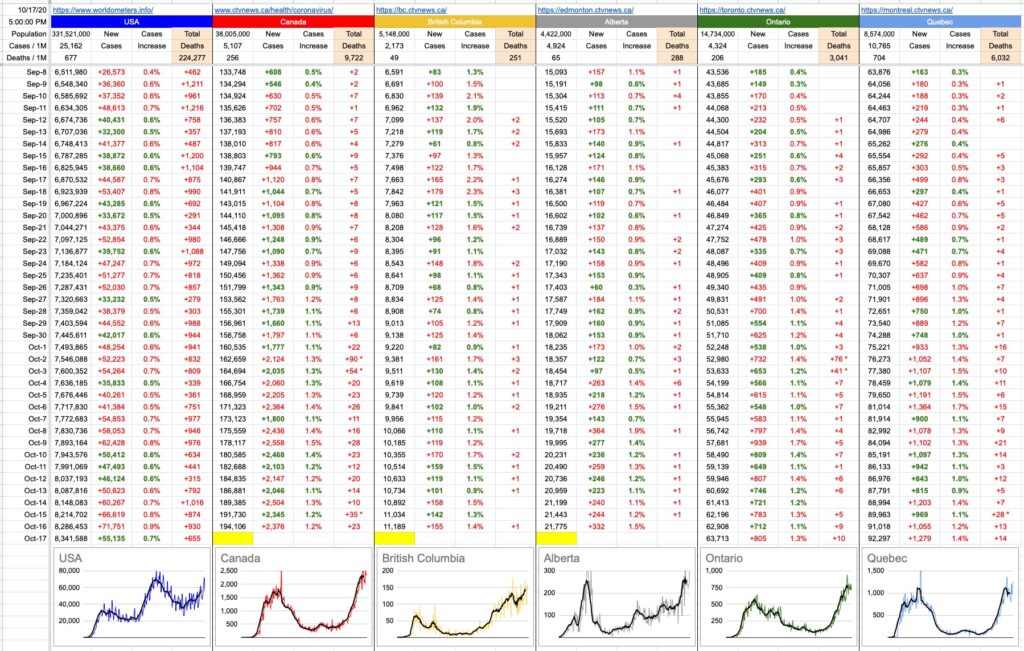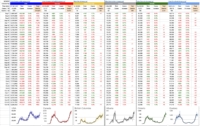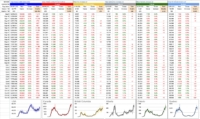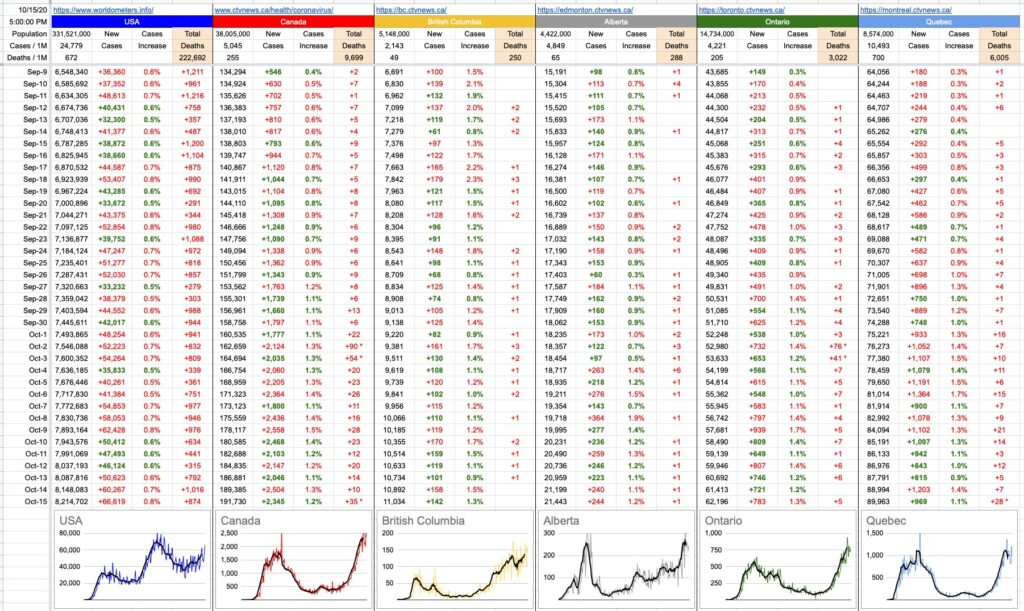Day 44 – April 29, 2020
It’s an interesting thing, this North American attitude… often found in sports. The great American pastime, baseball… there are no ties. The game can go into extra innings, which in turn can end up going on longer than the original game itself. In playoff hockey, same thing… full 20-minute periods until someone scores. Recall the famous Canucks/Stars playoff game that went into a 4th overtime — more OT than the 3 periods that preceded it. And hockey is a good example; there used to be ties in the regular season. And then… no, let’s decide this… they added overtime… and for a while, if the game ended in a tie after overtime, it remained a tie. But that wasn’t good enough… so, shootout. There will never be a tie again. There must be a winner. The most American of all games… the NFL actually allows ties, but there’s OT, with rules that make it almost certain one team will win. The only reason it can’t go on forever is that after more than 4 quarters of football, injuries are far more likely. There’s maybe one tie a year in the NFL; It’s rare, and nobody likes it when it happens. And NBA basketball? They will play overtime forever until there’s a winner.
On the flipside, the most popular sport outside of North America — soccer (fútbol!) — allows ties. What’s the difference in attitude?
I used to think it was attention span. Soccer holds your attention, sometimes for several minutes, between whistles. Hockey, same thing, which is perhaps why it’s not as popular as some of the others (especially in the U.S.). But football, baseball and basketball… endless time between action; time to discuss what just happened. Time to analyze it. Time to replay it, in slow motion, from different angles. That’s what I used to think, but no. What it simply is…. is that we just like to have a winner. After the big battle, a tie is just too unsatisfying.
It’s going to turn out that this virus is not as lethal as we initially thought… but, also…. it’s nowhere near as safe as a common cold or flu. The typical flu kills 0.1% of those it infects. COVID-19 seems to be somewhere between 0.4% and 3.4%. Let’s call it 2% for the moment. That makes it 20 times worse than a common flu. But also, nowhere near as bad as SARS (15% mortality) or Ebola (50% mortality).
The end result, somewhere in the middle, is the worst case scenario for the “I told you so!!!” crowds, because it means everyone can think they were right, and everyone else was wrong. It’s a sort of a tie that nobody likes, and both sides have plenty of ammunition to throw at each other.
In places that evidently haven’t been hit hard (B.C., prime example) the screaming about how we’ve wrecked our economy for nothing. Lockdown/shutdown — why? Look…for 100 dead people, most of them old or unhealthy to begin with? All of this suffering? For what?
On the flipside, places like Northern Italy and Spain and New York, who didn’t or couldn’t do enough to prevent the wave of catastrophic exponential growth in serious cases that led to a complete overwhelming of the medical system. And lots of deaths… multiples of excess deaths over the typical expected numbers.
Let’s look at some real numbers, implied by the general assumptions we think we know about this virus. The chart below shows ranges of age, and next to them, the mortality rate associated to that age group. Next to that, last year’s numbers for Canada’s population, followed by extending that mortality rate to our population. Knowing what we know today, if we were all infected and untreated, 750,000 of us would die, most of those being elderly. 750,000 people out of 37,500,000 = … 2%.
Age Mortality Canada Deaths
80+ 14.80% 1,614,000 238,872
70-79 8.00% 2,870,000 229,600
60-69 3.60% 4,607,000 165,852
50-59 1.30% 5,251,000 68,263
40-49 0.40% 4,817,000 19,268
30-39 0.20% 5,183,000 10,366
20-29 0.20% 5,101,000 10,202
10-19 0.18% 4,145,000 7,461
0-9 0.00% 3,982,000 0
TOTAL 2 .00% 37,570,000 749,884
That would never happen here, yells one side. That’s exactly what would’ve happened, yells the other.
On Friday, we will hear two things from Dr. Henry — one, that we have done our part and should continue to do so, and given what we’ve achieved, here are the first steps in the plan of re-opening our lives. And two, keep at it — an integral part of the new normal, at least until a vaccine shows up, will be maintaining the very things that have led to this success in the first place. That’s the side I’m on… and I’d like to think my side has done so well, that, by now, there’s probably enough hospital capacity to house the covidiots marching and protesting on Beach Ave. I’d like to think a small handful of morons isn’t enough to blow this for all of us… but time will tell.
View Original Post and All Comments on Facebook
Day 43 – April 28, 2020
Our local numbers shot up a bit today, but it’s a lot less concerning that in might have been a month ago, because we know exactly where and why this is happening… almost entirely due to known clusters playing themselves out — and play themselves out they do… some clusters have vanished, some care homes are down to zero and, for the most part, we have a really good handle on things. Things are on their way to re-opening.
Let’s also talk about some different numbers today, and what they imply.
In general, people talk about the stock market being up or down. Also, in general, it’s well understood that it’s good when the market is up, and and bad when it’s down. How does that apply to what’s going on these days?
First of all, let’s quickly define what we mean by “the market”. Everyone has heard of “The Dow”, and how it goes up and down.
The Dow (which refers to the Dow Jones Industrial Average — which is important to note, because there are other “less famous” Dow Jones averages) is an index that tracks, in real-time, the stock prices of a variety of big American companies, including Apple, McDonald's, Exxon, Boeing, Pfizer, Nike, Visa,, Walmart and Coca-Cola. That’s a little cross-section of the bigger mix… a variety of big industry. There are 30 companies that comprise the index, and you have heard of all of them. They are industry leaders, and how they’re doing is a reflection on the economy as a whole, at any given moment. On some days, when things are good and everything is way up, and the Dow will reflect that. Or the opposite, of course.
Today is a good day to use as an example, because it’s a mixed bag. Technology stocks (Microsoft, Apple, Google, Facebook) are all down. Financials (JP Morgan, Bank of America, Morgan Stanley, American Express) are all up. Consumer retail shares are a mix (Walmart, Proctor & Gamble are up, Amazon is down). Telecomm is also mixed bag (AT&T is up, T-Mobile is down, Verizon is flat).
Average it all out today, and the Dow is up… a little bit. There are other indexes to look at; the S&P 500 is the next most-commonly known, and it has a broader inclusion of the top 500 listed companies. It’s perhaps the best representation of the market as a whole. It’s also up a little today. Its little cousin, the S&P 100, which lists an arbitrary sample of those 500, is slightly down today.
At any given moment, what defines the price of an individual stock? It’s the equilibrium point where at that exact point in time, someone thinks buying those shares at that price is a good idea… while someone else thinks it’s the right time and price to sell. And these days, that someone is just as likely to be a big, intelligent computer.
Tens of thousands of shares are being traded every second, so when things get quiet (from a broad market price point-of-view), it’s an interesting oasis of calm before the next storm. Like, briefly, for a moment, everyone knows where things are at. Or, think they do…
Imagine you’ve been sitting on a little seesaw in the park, quietly enjoying smooth ups and downs with your friend. Suddenly, instantly, the seesaw grows to 20 metres long… and your friend is replaced by some gigantic bully that seizes his end of the seesaw and starts slamming it up and down, as hard as he can. You hold on for dear life, understanding that jumping off may hurt you more than just hanging on… and you just hope this giant jerk will eventually tire and go away, hopefully leaving you gently on the ground. This is what it’s felt like to be an investor these days.
The all-time high for the Dow was recent… before things came crashing down. On Feb 12th, the Dow closed at 29,551. From there began a bumpy ride that saw it lose 5,000 points over the next couple of weeks, before bouncing back up a bit. Then, in early March, all hell broke loose, and the wild swings of thousand-point gains and losses began, bottoming out at the lowest of lows, hitting 18,214 on March 23rd. And from there, it shot-up to 22,500. It’s presently sitting at 24,100… still well-off the high, but also significantly higher than that bottom. A 20% “off the high” is still alarmingly awful in such a short time, but it’s twice as good as the 40% bottom from a month ago.
Many people are saying it shouldn’t have dropped that far. Many are saying it should have dropped a lot further, and still could. Many are saying there’s no reason it should have recovered this much already. As per above, for everyone who thinks it should be higher, someone else thinks it should be lower. Those two people are presently buying/selling to/from each other, and that’s why it’s exactly where it’s at.
What caused these drastic moves? Unexpected news, rumours, fear… and, of course, real-world disclosures regarding the long-term effects of shutting down significant parts of the economy. And everyone absorbing that information, independently interpreting it and acting accordingly.
When things move that quickly, it rarely has anything to do with fundamentals. Nobody is looking at price:earnings ratios or dividend streams… more like trying to figure out market sentiment and just riding it out till things settle down.
At some point, when it’s fallen that far, a bounce is not just expected, but possibly predicted. The technical traders — those who care nothing about underlying companies but just analyze the numbers themselves… they love to pick resistance points… and identify trends in the market by when prices bounce off a price, or power through it. One of the most famous ones is based on the Golden Ratio — a relationship found all over nature. Flowers, pine cones, sea shells, dolphins, penguins… all have proportions and other fundamental constructs based on it. The magic numbers there are 61.8% and its converse, 38.2%… and whenever a market tanks, the first thing to look for is a “bounce off the 618” — which is exactly what happened to the Dow in my example above. Which further leads me to accurately assume that really, nobody knows what’s going on fundamentally, so when trying to figure out when to buy back in, “let’s just go with that”. When the Dow hit that 618 retracement, a lot of buying stepping in.
There is another index… it’s called the VIX… and if you Google VIX, you can instantly pull up a chart of it and how it looks. The VIX measures volatility, ie just how wildly things are swinging. The bigger the number, the wilder the ride.
The VIX never broke 20 in all of 2019… like you and your friend on the seesaw, quiet ups and downs. When the insanity began last month, that VIX shot up and broke 80 at one point, and has consistently been over 50 most of March. It’s recently started coming down, which is optimistically implying that things will settle down, at least to the point where maybe there’s some idea of what’s really going on. Call it cautious optimism as places start opening up and life shows some promise of taking its first steps towards normality.
And that’s market sentiment in a nutshell — nobody knows. Especially these days. Even in the best of the quietest times, there are always people on both sides of the seesaw. But the level of “unknown” these days is unprecedented… but I will tell you this, with certainty. The market will be hitting new highs… when? I don’t know. I will say September of 2022. But it could also be a lot sooner than that. Or, it could be a lot later. See what I mean?
View Original Post and All Comments on Facebook
Day 42 – April 27, 2020
Purely for the sake of creating examples, I am going to once again virtually kill a lot of people. Please don’t be sad… this is all made up as I go along.
- Older lady, sheltering with family. All of them became a little sick, but not sick enough to get tested. Some fevers and coughs. She dies in her sleep, but doesn’t get tested. A few weeks later, the family is tested and they’ve all had it.
– Young man, smoker, high blood pressure. Has a heart attack and dies. Tested and found to have had the virus.
– Elderly man, tested positive, was doing ok at home, but breathing is becoming difficult. Gets in the car, speeding to the hospital, blows a red light and gets T-boned by a truck. Killed instantly.
– Young man who, as a result of the lockdown, lost his business and is now losing his home, history of depression, commits suicide. Tests negative.
– Same example as above, but tests positive.
– Middle-aged man has a heart attack, rushed to hospital, but massive delay at ER… and dies while waiting for admission. Tests positive. Or negative. Whatever.I can come up with lots of “edge cases”, but perhaps they don’t serve much purpose other than to spark an interesting conversation. Some of these are obvious, some are not, and some, one could argue, should be… but aren’t.
The question you might think I’m about to pose is… what counts as a COVID-19 death… and yes, that’s part of it… but trying to answer just that question… can be quite problematic.
At the moment, there is confusion and disagreement with respect to what counts and what doesn’t. There is a certainly a big difference between dying of COVID-19, and dying with it. And there’s a lot of grey area in-between the obvious cases.
To compound the confusion, different jurisdictions have different ways of counting things… and many of them have changed their method as time has progressed. On April 14th, the state of New York changed what counts as a COVID-19 death, adding 3,700 to their count. More recently, Pennsylvania made adjustments that lowered their number by 200.
My examples above are only a tiny fraction of the sorts of cases one could argue one way or the other, and my examples are pretty superficial. When it comes to categorizing deaths where there were pre-exisitng conditions, it requires real medical knowledge, and even then… one lung is full of fluid but the other is not, patient was positive but that’s an unusual presentation of the virus, plus this, minus that… it’s up for debate among medical professionals, let alone everyone else who may have a vested interest in that number being higher or lower.
It’s complicated. And, obviously, necessary to standardize in the long run so everyone can be talking about the same thing. But in the meantime, there’s another number that’s very telling and, to a great extent, indisputable.
If you want to shut up the “it’s just a seasonal flu” crowd, and the “the death rate is like 0.04% because everyone already has it” crowd… look no further than excess deaths.
Excess deaths is exactly what is sounds like… if in a certain place, on average, N people die in the month of March, and historically that’s held quite accurately as X% of the population, then you have a pretty good argument for COVID-19 deaths when that number is N+2,000. Even if the official tally says only 1,500 virus deaths, you know it’s been understated by up to 500… which would indicate undercounting by 33%
You can then set aside the differences between states and countries as to what counts and what doesn’t, because after you factor out the obvious ones such as accidents, you have a bunch of deaths that are generally unaccounted for, with no category. There’s a good chance that this virus is their category.
This has been going on long enough that we can actually start looking at those numbers, to see if they reveal anything of value.
Note that there are times when averages are worth talking about… and there are times when they are not. Averaging the ages of passengers on a school bus full of kindergarten kids and their grandparents… tells us little. The average of 20 5-year-olds and 20 people aged 68 to 82… is about 40. And nobody on that bus is anywhere near that age. Two averages tell us a lot more… like one average is 5, and the other is 75.
Keeping that in mind… is there any consistency with respect to excess deaths?
Europe is a good place to look, with its diversity of population and experience during this pandemic. The average excess death percentage across 13 countries is 49%… which means for every two documented COVID-19 deaths, there was an additional one that flew under the radar.
As one might expect, the hardest hit places were Italy (90%) and Spain (51%). Those are two places where things got out of control quickly… and also where there is already enough data to make sweeping generalizations. If you look at graphs of what this looks like, The Financial Times, at ft.com, has an article titled “Global coronavirus death toll could be 60% higher than reported” with lots of little graphs, per country, to look at.
Note that this still isn’t apples to apples, because Spain and Italy were first, and are much further along their pandemic trajectory than others. In comparison, you might be tempted to look at other countries and think it doesn’t look so bad, but this is something to revisit in the future, when more than one month of data is available. Those graphs, per country, all show a series of flat, grey lines (previous years) and then the red 2020 line… which goes along quietly on top of the others and then suddenly spikes, sharply and quite alarmingly in most cases. What’s interesting to see is that these spikes are like ocean waves… and there’s no way to tell if that wave is crashing, or whether it’s the first part of the wall of a tsunami. Ideally, it spikes right back down again… and Spain and Italy may well be doing that. The others; the jury is still out. The England/Wales number is “only” 37%, but that graph looks ready to continue to rise, and/or at least continue to fill a long red section. As do many others.
And when you drill down to certain, known areas of concern… New York City — forget the official stats… they have a 300% excess death-rate to look at. London, 96%. Paris, 122%. Stockholm, 75%. And if you look at Northern Italy, specifically the hard-hit Bergamo province… 464%.
He are some raw and indisputable numbers of how it looks when things don’t get clamped down. Lots more people die, directly or indirectly, as a result of this virus.
These places seems distant and irrelevant to some of us here, lucky enough to live in a place with 39 new cases yesterday and only 11 today. And that’s a result of doing things right. It’s not just luck.
View Original Post and All Comments on Facebook
Day 41 – April 26, 2020
Today is the quiet day with numbers, so not much to say except let’s see how tomorrow pans out. Yesterday’s spike around here is mostly attributable to a few known and developing clusters, but we’re at the edge of the 14-day window after the Easter long weekend… so its effects, if any, may also be coming to light. I’ve just guessed at today’s B.C. number, but for what it’s worth, Ontario today saw it’s lowest numbers for new cases and deaths in two weeks; more signs of everything going in the right direction.
I’ll adjust numbers tomorrow when we get a real update, but for now, with not much more to add, writing yesterday’s airplane post reminded me of something that happened about 20 years ago… just before 9/11, when there was a whole lot less security… almost non-existent in some airports. So I’ll tell you about that.
I was traveling from Chile to Costa Rica, via a brief stop-over in Lima, Peru. The usual pit-stop for fuel and more passengers.
The city of Lima is right on the coast, and the airport is next to the water. Having stopped there before, I knew there had been a time when they'd make you get off the plane and go to the waiting area, where they'd hoped you’d spend your hard-earned dollars on low-grade over-priced Peruvian artisan crap. I guess nobody ever bought anything because now they’d given up; now you wait on the plane. In fact, as punishment, except for those whose final destination was Lima, nobody was allowed off the plane.
The plane lands, the doors open, air-stairs pull up. The plane is out in the middle of the tarmac, so they open both the front and back doors, allowing the lovely midday breeze to flow through the plane. The sickly aroma of trash, rotting fish and jet fuel is a "refreshing" change. The holy trifecta of nauseous smells, all conveniently packaged for your travelling convenience.
They leave the doors open because those guys in orange vests and clean-up people and inspectors and whoever are all walking through, and then the new passengers start getting on as well. The plane's air-conditioning hasn't been turned off during any of it, so the smells are well-infused into the system by the time they close the doors.
A few people are complaining about the smell, but the stewardesses are helpless. They shrug their shoulders and make sympathetic noises about spraying deodorizer once we're in the air. I've got my face buried in this little "eye-pillow" — it's not very big, but it's full of Lavender and Sage and other wonderful-smelling herbs.
Fast forward to about an hour into the flight… the smell hasn't gotten any better. In fact, it's worse — especially the fish aspect of it. It's really bad. I'm wondering how it could possibly be getting worse; that doesn't make too much sense. What sort of air system amplifies bad smells?
Suddenly, there's gasping and shouting coming from the back of the plane… and then, the most awful pungent disgusting stench you can possibly imagine overwhelms the entire cabin. Someone had decided to open the overheard compartment to get something. Well, as you well-know, be careful when opening the overhead bins… items may shift during flight…
As it turns out, one very special sort of idiot boarded the plane with fish. Not a fancy wooden box of freeze-dried Canadian Salmon sort-of-thing; not the overpriced touristy last-minute gift-shop vacuum-sealed sample of the local delicacy… not a jar of herring… not a can of sardines… no, not that…
No… this was a good old-fashioned styrofoam box with a loose lid, and a fish or two thrown in it… and the styrofoam box and at least one of its occupants now found themselves on the floor of the plane. I was in the window seat, so really couldn’t see to the back; I was relying on the play-by-play of the lady on the aisle, and here are some of her comments, translated from the original, colourful Spanish:
"For the love of sweet Jesus and his sainted mother, he has a fish!"
"For God's sake, I think the fish is alive, it's moving! Oh, no, it's just that some guy is stepping on it"
"That little girl is going to be sick, I just know it, I can tell, I know these things. See, I told you"
It really is hard to describe. I mean, we've all smelled fish. We've all smelled rotten fish. But if you've ever been in a cigar tube 7 miles above the ground with no opportunity to open a window — well, it does add a whole new dimension to the experience. And add to that, the variety of sounds and smells of other people becoming ill. I recall the guy on the other side of the aisle in the "crash position" with his head between his knees. He was next.
After a lot of hysterics, things got better. They found some plastic wrap and sealed the whole mess. They sprayed some powerful, good-smelling stuff on the fish juice on the floor… and throughout the cabin. And free drinks for everyone. All good.
Thinking back on it… and I realize this was before 9/11, but still… can someone kindly explain to me how someone manages to get a box of fish onto an airplane? Was the guy at the X-ray machine asleep? Didn't care? That X-ray must have been hilarious to see, a literal fish skeleton. Hey sir, mind if we look in the box? What’s in here? Oh, fish, of course, that’s what we thought. I mean, that’s what it looked like and we could smell it a mile away… just wanted to verify! Have a great flight!
Agh.. you know, we were going to order sushi tonight. Now I’m not so sure.
View Original Post and All Comments on Facebook
Day 40 -April 25, 2020
When I was a kid, I used to ride my bike all over the place… without a helmet. Also, when I was a kid, I was taken to many soccer practices and games in the back of a station wagon — the coach’s car served as a sort of team bus… and since I was near the end of the “bus route”… I’d end up thrown in the back, along with the soccer balls and oranges… all of us bouncing along to the endless rhythm of a creaky suspension. And… quick right turns and pot holes… often, the trip to and from the field bruised me up more than the soccer itself.
Such was the spirit of how it was in the late 70s, so it won’t surprise anyone to learn that flying in those days was also a little more lax. On family trips where the plane’s seating configuration was 3-4-3, we would be in that middle section… my parents on the aisles, my sister and I trapped in the middle… and that was ok, because on long flights, one of us would curl up on the two middle seats, and the other on the floor. And, to be honest, I preferred the floor. There was more room there… and sometimes, if we had the bulkhead, we’d both wind up there… sleeping on the floor, for hours. Seatbelts? LOL. The flight attendants would provide us extra pillows and blankets and smile at the cute little kids sprawled out on the carpet.
Back then, you could smoke on planes, and many people did. In my earliest memories, the entire plane was one large smoking pit. But I have an excellent memory of when they instituted a no-smoking section, at the back of the plane. My parents booked seats back there, but when got to our four seats, every other seat around us was already occupied, many of them with people smoking. My father found a flight attendant and asked… aren’t these supposed to be no-smoking? “Oh sorry… yes….” she replied, and then proceeded to velcro onto our four headrests these little fabric “No Smoking” logos. Perfect… problem solved.
I remember that flight in particular… because I sat there, unable to sleep, and inhaling 2nd-hand smoke for 8 hours. And I remember that whole charade of the the no-smoking nonsense…. like, forget the ridiculous and meaningless logos attached to our seats, ironically perhaps, given that we were the only people within 3 rows either way who didn’t smoke… but, seriously, what difference is it going to make anyway. If one single person on this plane is smoking, we’re all smoking. It’s not like we can open a window, and there’s only so much recirculated air filtering can do with that volume of smoke. On top of that, we were so far back, we couldn’t see the movie… which was one big crappy projection screen 30 rows ahead of us, blocked by 100 heads, faded and scratched with time, barely visible through the haze of smoke… and the sound wasn’t electronic headphones but rather these plastic tubes that conducted sound via air, not electrons. The whole thing sucked.
It’s ludicrous to imagine that, with a straight face, an airline can offer a no-smoking section… like rows 10 to 29 are smoking, but 30 to 50 are not. The guy in row 31 has a pretty valid complaint when he says he didn’t sign up for this.
Similarly, today… the guy who lives in Alabama, but near the Georgia border…
OK, let’s back up a bit and expand my little airplane metaphor. What if this 50-row plane was… umm, “governed” by 50 different flight attendants. And each flight attendant could make their own rules about what gets to happen on their particular row. Row 11 is no smoking, but free drinks. Row 14 is smoking but no drinking. Row 17 allows smoking, but only cigars and pipes. Row 20 was promised as no smoking and no drinking, but the raucous from the 10 rows in front of it are making it an unpleasant journey for those folks.
To a great extent, when everyone booked their seat, they really didn’t know what rules would apply, nor did they realize that they might change “on the fly (haha)”, but many are complaining that it’s not fair that row 25 gets this, but row 29 does not. The plane hasn’t even taken off yet, and it’s chaos… and, typically, when there’s confusion in the cabin, the flight attendants look to the captain and co-pilot for guidance… but let’s not go there again.
Back on the ground, the state Georgia, as of yesterday, is back in business. Some of it, anyway… including gyms, fitness centers, bowling alleys, body-art studios, barbers, cosmetologists, hair designers, nail care artists, estheticians and massage therapists. It’s a curious list… gyms? Fitness centres? Bowling alleys? Places where lots of people breathe hard, touch common surfaces and are in close quarters? Should be fine.
Since there is no relevant leadership at the federal level, and no federal guidance… it’s up to the 50 states to decide what they want to do. Given the individual differences and motivations and lobbying efforts at the state level (Gyms? Bowling alleys?), things will be 50 versions of different. And that can turn out to be a pretty serious problem, because the cigarette smoke from Georgia will most certainly drift into Alabama. And Florida, and Tennessee, and the Carolinas.
There is understandably a tremendous amount of pressure to get things going again. Around here, there’s a plan in place, based on what we’re seeing and expect to see in the near future. Today’s jump in numbers in B.C. can be attributed largely to the breakouts in known clusters, in this case, a correctional facility. That’s one number to look at, but just as important are hospitalizations and ICU cases. There’s no jump there. And generally speaking, across the country today, encouraging signs that the trend continues to show a slowing of growth. TTD numbers used to be a few days… and now they are a few weeks. This is exactly what we want to see to line things up for re-opening the province… and the country.
But doing so requires a coordinated effort, with buy-in from everyone.
Looking below the 49th, doing it differently all over the place guarantees one thing: everyone, doing something different, can’t all be right. Which means in some places it will be wrong… how wrong, and the effects of that… remain to be seen.
Fasten your seatbelts, my American friends… there’s turbulence ahead. Rest assured, the plane will eventually land safely… but it’ll be a bumpy ride.
View Original Post and All Comments on Facebook
Day 39 – April 24, 2020
Yesterday, I talked about the dinosaur apocalypse… how they were all wiped out. But, to reiterate, the only ones that were fully wiped out were the ones on the ground. As hard as it is to believe, and I know some will take exception to this… but… birds… are not descendants of dinosaurs. They are dinosaurs… the ones that survived that cataclysmic event 65… sorry, 66 million years go.
That cataclysmic event was so… umm, cataclysmic… that it wiped out 75% of all species on earth. That was fortunate for those who survived, because it gave them the evolutionary advantage to thrive, among them… mammals.
It’s a long line of evolution between those mammals and the first hominoids… but it does beg an interesting question; has the human race ever been close to extinction? Terrestrial dinosaurs were around for close to 200 million years. Humans have only been around… well, depends how you look at it. With broad brush strokes, the human animal… maybe 300,000 years… but we only began to exhibit what you might call “modern behaviour” around 100,000 years ago.
What would’ve happened if a pandemic-capable virus had shown up? Not much, because there was next to no overlap of communities distanced by geography. It makes one wonder, how often have there been these sorts of viruses over the centuries? Probably lots. But it was localized, there was no treatment, there was no social distancing… all that happened was a big wave of very sick people dying, and eventually through herd immunity and/or lots of death, the virus made its way through everyone it could, and then disappeared from existence.
But the human race actually did come close to extinction, and it wasn’t that long ago, geologically speaking. Well, this is one theory. It’s interesting, as usual, to research things on the Internet because you can always tell where the conformation bias lies. You can tell what people want to believe, and how they conform their evidence to support their side.
Around 75.000 years ago, there was a massive volcanic eruption — one of the biggest ever. The Toba Supereruption (Lake Toba, Sumatra, Indonesia) erupted and ejected some 2,800 cubic kilometres of magma. That is a staggeringly huge cube of hot, melted rock… and it left behind something the same size as the crater that took out the dinosaurs… an enormous 100 x 30 km caldera complex. Once again, it messed with the environment very significantly… the six billion tons of sulphur dioxide that were ejected into the atmosphere caused a global cooling of up to 15 degrees all around the planet for at least a few years, and it was many decades before things returned to normal. This lowered the tree line and snow line by about 10,000 feet… and for humans who were used to a dry, temperate climate, years of perpetual snow did not sit well.
There is a genetic bottleneck at the time when looking back at humans, meaning it seems we can all trace our DNA back to a small group (like a few thousand humans) who made it through that. The rest were wiped out. And to some extent, if that’s what happened, you have to assume we’ve all evolved from a pretty tough group of humans. This was survival of the fittest imposed in the harshest of ways.
This is one theory, and it’s very interesting. There is another group of scientists who claim that’s hogwash, and that the evidence doesn’t necessarily imply any of that.
Whatever the case, all of that I learned yesterday while digging into dinosaurs… you know how the internet can be… one moment you’re reading about what you were researching, like dinosaurs and their extinction… and 40 minutes later you’re reading about mentally ill monarchs throughout human history.
That’s a good little segue onto a topic I really don’t want to touch here. I had a whole thing written out, and indeed, I could write a book on my thoughts with respect to American politics of the day, but this is a scientific and statistical endeavour, ostensibly aimed at keeping track where we are with respect to this pandemic. On that note, it’s not irrelevant to point out, as I have earlier, the shortcomings I see when it comes to leadership pulling in different directions, etc etc. But I just deleted many paragraphs that delve into far more detail, and will leave it at that.
OK, one paragraph. I worry greatly for the great country of the United States of America. Every single day, thanks to the actions or words of just one man, the chasm that separates two groups (big broad brushstrokes here: Republicans and Democrats) — gets a little bigger. It started on day 1, lying about the inauguration crowd size. “Who really cares” is really what should have been the answer, but he chose to lie about it, then double down on his lies, then make others lie for him… it was bewildering, to be honest. What the hell is going on? There was incontrovertible evidence… pictures and witnesses and everyone who was there… but no. It ended up with “alternative facts” trying to be jammed down our throats. All of this on day 1 of his presidency. And since that day, whenever he says or does something that is completely unpresidential, both sides rise to the challenge. And while the argument rages on about who’s right and who’s wrong, the country slides a little bit more downhill. This is not to bash on Republicans and Democrats… there was a time when both those parties worked in harmony for the greater good of the country, especially in times of crisis. I really wonder how repairable this is now. Long after Trump is gone, the degree of bipartisanship needed to successfully guide a country — may not be achieved for many, many years. And I’m not interested in the bullshit arguments of what a great job he’s presently doing. He’s not. I don’t use vague handwaving and gut feel to come to my conclusions, I use hard facts. As you may recall, this entire project of charts and graphs and light commentary started with a simple exercise of trying to track Canada’s response to this crisis as measured by comparing the U.S. and how they were doing. And comparing them to Italy, who was ahead of them. The short answer now is: Awful. Brutal. Look at the numbers, look at the graphs. This isn’t fake news, this isn’t opinion. These are their numbers. These are confused people. These are hospitals that can’t keep up. These are states and leaders with mixed messages. These are deaths. These are the preventable disastrous blue line and its associated numbers, towering over the green, red and black ones below it. This is failed leadership, from the very top.
Sorry for the long paragraph… but I did say, just one paragraph. But, some numbers… Canada, today, flat or better growth all across the country. U.S…. more deaths today than the number of new cases in Canada. Also U.S., more deaths today than the entire number of known cases seen in B.C., active or resolved, since the beginning of this pandemic. And finally, U.S., more new cases today than all of what Canada has seen, combined, since day one. By the end of the weekend, the U.S. will have seen its one millionth case. Canada will be below 50,000. That same proportion maps to deaths. And some quick math for you… no, the population of the U.S. is not 20 times that of Canada. Not even 10. As President Trump likes to sign at the end of many of his Tweets: Sad.
View Original Post and All Comments on Facebook
Day 38 – April 23, 2020
When I was a kid, I was taught that the dinosaurs died out sixty-five million years ago. More recently, my kids, when they were in elementary school studying dinosaurs… were taught that they died out sixty-six million years ago. How exactly did a million years elapse in less than 50? Was it at 65,999,980 in the late 70s, and it just recently “rolled” over to 66?
No… but something must have changed, and it did, from various directions. Geophysicists, geologists, palaeontologists and other researchers… all working on completely different things — some drilling for oil in the Gulf of Mexico, some working on hypotheses regarding the mass-extinction event from around 65 million years ago, some researching a very thin but fossil-diverse soil layer in New Jersey from around that time period… at some point, in the early 80s, someone asked the “what if…?” of a meteor/asteroid/comet slamming into earth might hold some explanations… and indeed, the puzzle pieces all fit. And, further to that, if that were the case, we should also be finding other things, specifically… well, this and that, and when “this and that” were searched for, they were found. Including dating that massive crater to just over 66 million years.
That crater (the Chicxulub crater — 100km wide, 30km deep) was caused by a piece of rock somewhere between 11 and 81 km in diameter, slamming into the earth with a force of somewhere around 500 billion Hiroshima A-bombs. That’s a lot of bombs… so let’s do some ridiculous math…
Each bomb is 3 metres long…. so if we line them up, end to end, that’s 1.5 billion km. That’s from earth, to the sun… and back. Five times. Or back and forth to Mars, four times. Or one, nice long line of A-bombs… from here to Saturn.
So imagine all that firepower concentrated in one spot, all blowing up at once. It’s a wonder the earth itself survived. It did, though the massive earthquakes and tsunamis and acid rain and volcanic eruptions and blocked-out sun for years… did not make for great living conditions. All of the terrestrial-based dinosaurs were wiped out, and all that’s left of them are the ones that could literally fly above disaster below. Indeed, from a dinosaur’s point of view, we are all living in a post-apocalyptic world.
And how do we know all this? Science. Knowledge attained through study and practice. Knowledge acquired through the rigours of scientific testing, which itself implies a methodology that includes proving hypotheses though experimentation, data-collection and analysis. It’s not vague hand-waving and guesswork.
Which is why it’s getting a little frustrating listening to some of the nonsense spewing out of the mouths of some politicians and business leaders from around the world. Yeah, we get it — the economy is in shambles. We need to get back to normal. Everybody is suffering. But when the vast majority of scientists agree on something, they’re probably right. And when it’s not what you want to hear, that doesn’t make them the bad guy. Listen to them. Don’t fire them. We are all suffering through this present situation, and the virus doesn’t care who you are, what your political motivations are, how much money you’re losing every day. But the virus does care about surviving…if it could think, that’s the only thing it would care about. In fact, if it could survive without causing you any bad side-effects, it’d probably choose that, because then it could propagate further and guarantee its survival. Either way, it’s not going to go away on its own… and its efforts to survive hurt us… and if we left it to run wild, we would be in a world of hurt.
Many different scientists are working on this. Not geologists nor palaeontologists. More like epidemiologists, microbiologists, immunologists, virologists and biotechnologists. And a whole host of other “…ists”. Today, they say things like “social distance” and “lockdown”, and for that, they’re the bad guys. One day, when the same people are saying, “here’s a vaccine”, they will be heroes.
They’re already heroes, thrown into a spotlight none of them ever wanted. “Leave me alone to do my research for the greater good”, they would tell you… but instead, they seem to face the wrath of those who don’t want to deal with reality because it conflicts with their electorate and/or bottom line.
Once again, and I’ve said this countless times… we’re very lucky around here. We have scientists who know what they’re talking about and we have politicians who listen to them and we have business leaders who understand the big picture. Looking around the world, we seem to be in a fortunate bubble of intelligence, harmony and cooperation… which is why if we do what they say, we will all get out of this sooner. And today is a good example; only 29 new cases here in B.C., including cases in known clusters… which means, at most, only a handful of new community cases. No jumps in hospitalizations or ICU cases. Steady as she goes.
And by the way, scientists… you managed to adjust that dinosaur number by a million years… we’ve been at this for about 4 months now… and back then, we were being told a vaccine in 12 to 18 months away. Can we adjust that a bit…? How about 8 to 14 months?
View Original Post and All Comments on Facebook
Day 37 – April 22, 2020
I left the house yesterday, for the first time in a while. Some things need to be done in person… I drove downtown to my bank’s main branch, one of the few that’s open. With all of it pre-arranged, I put on a mask, gloves… walked in, put down a piece of paper, grabbed some cash and left. It took less than 2 minutes. I’d like to pretend the mask was so they wouldn’t know who I am, and the gloves so I wouldn’t leave fingerprints. The piece of paper would’ve been a stick-up note, of course… I was alone, so I just went back to the car and drove home… but I wish I’d have had a driver, so I could’ve jumped into the car and screamed, “Step on it!!” — because that whole episode was about as close as I’ll ever come to robbing a bank.
The drive home reminded me of when I got my first car in 1986. Driving up and down Granville St. in the middle of the day with so little traffic — that’s what it used to feel like driving here 30+ years ago. It also reminded me of how I used to drive in those days… in an effort to always be able to speed off with no traffic in front of me. Like, if you’re on a road with two lanes going your way and you’re approaching a red light, and there’s a car stopped there in one of the lanes, you change to the open lane. Or if there are already two cars there, pick the one that’s likelier to go faster than the other, so you can find that space to go around both of them. Switch lanes to follow the faster car. When one is a truck and the other is a Ferrari, it’s easy. Or when the guy in the left lane is turning… or the one in the right lane is turning, but there are pedestrians. Whatever the case, pick the lane that’ll open up quicker.
But what happens when both are the same car, like identical? And you didn’t notice which one approached the light quicker. It could go either way… so you have to make a simple guess. And if someone behind you is also approaching the light, and they think the same way you do, they’ll see two cars in one lane and one in the other, and simply pick the emptier one. Now that guy is next to you, and neither of you knows who’s going to go faster.
What’s interesting about that situation is that you got to go first in making your decision… but it might not be to your advantage. You zigged, so he zagged in response. You acted, he reacted. Going second is often the easier choice, especially if there’s something to learn from the guy who went first… but even if there’s nothing to learn, the guy going first isn’t always right, and when he’s wrong, you get to be right. And when you do get to learn something… well, imagine a game of Rock-Paper-Scissors where you get to go second… a moment after your opponent has thrown their move. Not much of a game.
It’s generally accepted that going first in chess gives you an advantage, at least initially. White gets to go first, and most chess players prefer white. That was easy. But when it comes to handling the huge unknowns of a global pandemic… things aren’t as simple as Chess Club.
The world has given us plenty of examples. There’s a “let’s learn from the others” club. Canada is part of that club. New Zealand as well, one of its proudest members.
There’s the “we’ll do it our way” club, with the U.K. as the charter member, and Sweden joining in later, even after the founding nation cancelled its membership.
There’s the “we’re too unorganized to respond properly, for a variety of reasons”, where the U.S. is the predominant member, but others are scrambling to join.
There is also the “we knew what was coming and saw all of the examples but still didn’t respond properly” club, and its newest member is Mexico. They are suddenly realizing a lot more could have (and should have) been done, but now it’s looking like that lack of flattening the curve will lead to a situation where their medical infrastructure can’t handle it. Or, conversely, as other sources claim, there’s no problem that can’t be handled. And into the mix, no mandatory isolation… and public fighting between the private sector and the government, with some business leaders demanding the country stay open and urging people to ignore suggestions from the health minister. Throw into the mix the drug cartel, who themselves are handing out care packages to people (rice, pasta, cooking oil, toilet paper) with pictures of “El Chapo” on them… against the expressed wishes of the government. The model where everyone is pulling in different directions, to better serve their own individual needs or beliefs… has not worked well. Here comes one more member for that particular club… one you don’t want to join.
Closer to home… there was a spike in new cases, but it was to be expected. The outbreak in the poultry facility is just one cluster where testing is catching up to the outbreak… so we may see bigger numbers in the coming days, but they don’t necessarily reflect a bad trend; in fact, hospitalizations and ICU cases are at their lowest levels for the month. But… it does imply… we have a ways to go before the real openings can begin. These numbers need to go down, steadily… not just keep level. Let’s all keep doing what we’re doing… as fruitless as it sometimes seems, because things are going so well around here; it’s because of what we’re doing that they are… and let’s not wreck it. We’re getting there. But you want it to be over now, and I get that too. Join the club.
View Original Post and All Comments on Facebook
Share...
October 19, 2020
Right around the time the distinguished Dr. Anthony Fauci was being awarded the National Academy of Medicine’s first-ever Presidential Citation for Exemplary Leadership, the president himself was quoted as saying, “People are tired of Covid. I have these huge rallies. People are saying whatever. Just leave us alone. They’re tired of it. People are tired of hearing Fauci and all these idiots.”
There are indeed idiots in our midst, but Dr. Fauci is not one of them. However, if you want a good sampling of idiots, look no further than this weekend’s “B.C. Freedom Mega Rally” – 1,000 Covidiots, standing unmasked, shoulder-to-shoulder, at the usual rallying-spot… the Art Gallery plaza.
In no particular order, they were protesting censorship, lockdowns, mask mandates, vaccine mandates, quarantines, travel bans, social distancing, contact tracing and government orders. Also… claiming it’s all a hoax, and supporting wild conspiracies, anti-vaxxers, white supremacists and neo-Nazis.
Oops… well… that escalated quickly.
To be clear, not all Covidiots are anti-vaxxer, white-supremacist nazis. I suppose you can be anti-mask or anti-vaccine or anti-quarantine without being a racist freak. But, interestingly, all anti-vaxxer/white-supremacists/nazis are very much against masks and vaccines and quarantines. We don’t see any white supremacists supporting social distancing. We don’t see any neo-nazis with swastika masks.
That should tell you something. Birds of a feather, etc.
In the meantime, the world-wide case number went over 40 million. Over a million have died. Canada just went over 200,000 cases. More than 4,000 people here in B.C. are in quarantine. This is far from over, and it will get worse before it gets better.
Dr. Henry added a fourth word to her mantra today… Be calm, be kind, be safe… and, be brave.
Yes… seeing what’s going on all around us, it’s certainly going to take some bravery to get through this.
October 18, 2020
No new numbers till tomorrow, but here’s something older that you may remember, especially if you’ve been reading these updates since the beginning. Today’s graphs aren’t the usual up-to-date provincial and national tallies. Rather, these are what those original Time-To-Double (TTD) graphs look like today.
Early in the pandemic, when things were spiraling out of control, the TTDs were being measured in handfuls of days… 2, 3, 5… that’s what we were witnessing in places like Italy and Spain and, for a little while, severely-affected pockets of the U.S. That’s what we were hoping Canada would avoid.
While things are still growing exponentially, the TTDs are way down. The recent second wave is certainly visible, especially in the left-most (non-logarithmic) graph, but the TTD line on which Canada sits is 20.
The middle graph is the same as the one on the left, except represented with a logarithmic Y-axis… which straightens out the curves of those dotted exponential TTD lines, and serves to represent the rate of exponential growth (or lack thereof) compared to the beginning.
The graph on the right is what Canada looks like compared to the U.S… and since the Y-axis is “compressed”, it makes things look a lot closer than they actually are. Rather than scaling up evenly, every Y-axis grid line on those two right-most graphs represents 10-times the growth. The red line is just below 200,000. The blue line is above 8,000,000.
All that being said, the Canadian graphs’ hockey-sticking up-to-the-right is quite evident, both nationally and provincially. What we’d obviously like to see is for them all to flatten out again… which one day they will.. but, hopefully, sooner than later. We know what we need to do to make that happen…
October 17, 2020
We are exactly one week away from the election… no, not *that* election – that one is 17 days away and approaching quickly… but I’m talking about our local Provincial election… and all I have to say about it is… vote. Just go out and vote. You don’t have to wait 10 hours in line, like in some attempted-voter-suppression ridings in the U.S.
Around here, if you haven’t (safely and conveniently) already mailed it in, you can vote in person. It takes 2 minutes, especially if you vote early and don’t wait until next Saturday. Advanced polls are already open, will be open throughout the weekend, and are around until Wednesday. They are virtually empty most of the time.
It wasn’t that long ago that more than half the people reading this post wouldn’t have been allowed to vote… due to race or gender or some other discriminatory reason. But a lot of people went through a lot of trouble to grant you the right… so the least you can do is exercise it.
And if you’re so out of tune that you’re not even sure what’s going on nor who to vote for, simply Google “BC election cheat sheet” and read that article… it’s as good a starting point as any, and you can walk into that polling booth armed with some real knowledge and ownership that you’re putting you vote toward ideals in which you believe.
October 16, 2020
This is pretty long… not only because I couldn’t make it any shorter without leaving out something I consider important, but because I have a busy weekend ahead and might not get a chance to post much. No new local numbers till Monday anyway, so here’s most of the weekend’s updates in one convenient place… and we’ll start on the opposite end of the country.
About 25km off-shore from Newfoundland, you’ll find a collection of 8 little islands. They’re not very big. Collectively, they’re about 1/10th the size of Metro Vancouver. They’re known by the name of the two biggest islands, St. Pierre and Miquelon. Not relevant, but in case you’re curious… their population of 6,000 has had 16 cases of C19, 12 of which have fully recovered and 4 of which are still ongoing.
That entire population lives on those two islands, where they do a lot of fishing and play a lot of hockey. No big deal, except if you’ve never heard of them, you’ll be quite surprised to learn that they’re not part of Canada. Even though they’re closer to Newfoundland than Vancouver Island is to the mainland, they’re 100% French. Not like Québec French. Like French French.
How they got to that point is a long and interesting story… Indigenous people, Portuguese, Spanish, French, English, American, Canadian… all have laid claim to the islands at some point over the centuries… but, as it often goes with land grabs/invasions/conquests, whoever had it last… gets to keep it.
And that was France, who, despite opposition from Canada, Britain and the U.S., seized the islands during WWII… seized by that troublemaker Charles de Gaulle… the same one whose “Vive le Québec libre” 20 years later started a shitstorm that will never go away.
But since then, these little independent French islands have been happily doing their thing, and for the most part have a very close and functional relationship with their Canadian neighbours. A little border dispute or fishing-rights argument pops up occasionally, but it’s never a big deal. It always gets worked out.
Have you ever wondered what would happen if Trudeau suddenly went nuts and invaded those islands? It would be a very weird situation for us, but also for our allies, especially the U.S. and the U.K…. both of which are always … [Continue Reading]
October 15, 2020
There has to be something inherently wrong with a political system that can so brazenly show everyone the middle finger, with zero care or concern, and face zero repercussions.
The Republicans are blatantly trying to give themselves every possible advantage, legal or illegal, that they can in this election, and while it seems the media does what it can to report on it, the people pulling it off just laugh, don’t care… and just carry on. The shenanigans are blunt and transparent.
The most blatant of all has to do with the infrastructure that’s going to decide the election. Trump himself has made a lot of noise about mail-in ballots and absentee ballots… which for some reason are patriotic and acceptable and honourably welcomed in Republican states, but vilified and fraudulent in Democratic states.
And now, ballot-drop boxes in Republican states are being limited to one per county… but in California, a Democratic state, the GOP themselves are putting up theur own (illegal) ballot-collection boxes. They have been handed a cease-and-desist order… but have chosen to simply… not cease-and-desist.
Can you do that? The last time I checked, laws and court orders exist to uphold some semblance of civilised society. You don’t get to pick and choose which laws apply to you and which don’t; that’s a fundamental point of democracy.
But no… the Republicans, empowered by their “anything goes” and “make it up as we go along” leader, are doing their part. “What will help us win this election?”, they ask… and the answer is pretty simple, depending on where you are; either they will help you cast your vote, or they will help to suppress it. Every vote counts. We are all equal. Until we decide what counts and what’s equal.
To whom are these illegalities accountable? Remember Orwell… everyone is equal. But some people are more equal than others. What does that mean? Well, you’re seeing it play out with your own eyes.


